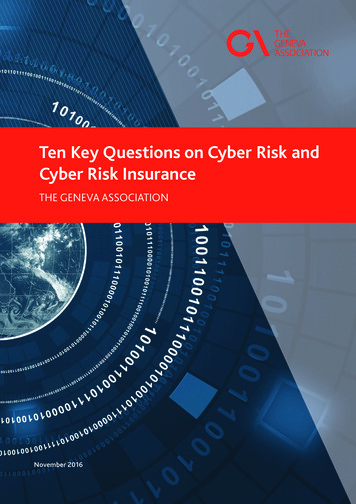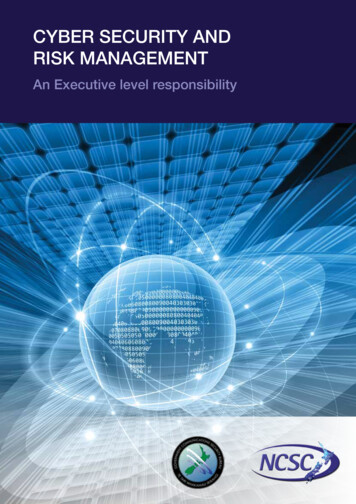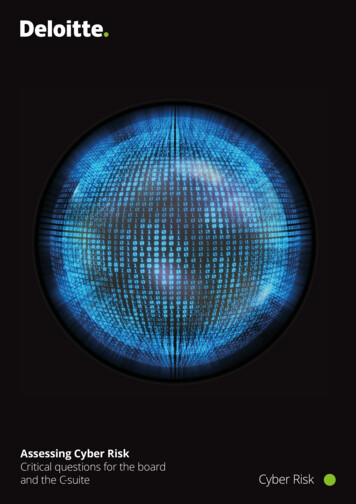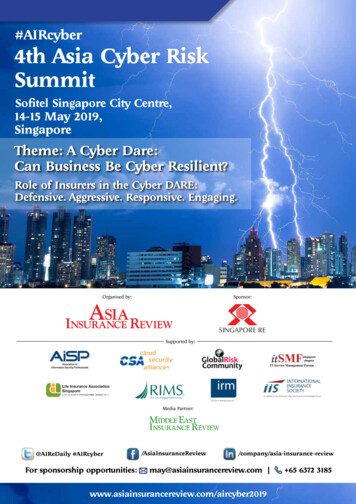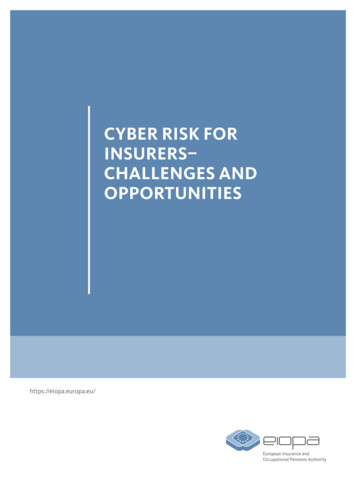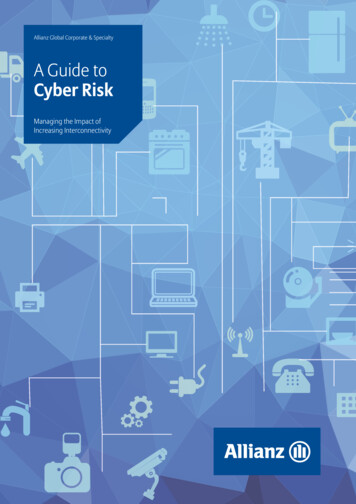
Transcription
Allianz Global Corporate & SpecialtyA Guide toCyber RiskManaging the Impact ofIncreasing Interconnectivity
Scope of the ReportScope of the ReportCyber risk is now a major threat to businesses. Companies increasinglyface new exposures, including first-and third-party damage, businessinterruption and regulatory consequences. With the operatingenvironment for many industries changing dramatically, as they becomemore digitally-connected, this report examines cyber risk trends andemerging perils around the globe. It also identifies future mitigationstrategies, including the role of insurance.About Allianz Global Corporate & SpecialtyAllianz Global Corporate & Specialty (AGCS) is the Allianz Group’s dedicated carrier for corporate and specialtyinsurance business. AGCS provides insurance and risk consultancy across the whole spectrum of specialty, alternativerisk transfer and corporate business: Marine, Aviation (incl. Space), Energy, Engineering, Entertainment, Financial Lines(incl. D&O), Liability, Mid-Corporate and Property insurance (incl. International Insurance Programs).Worldwide, AGCS operates in 28 countries with own units and in more than 160 countries through the Allianz Groupnetwork and partners. In 2014 it employed more than 3,500 people and provided insurance solutions to more thanhalf of the Fortune Global 500 companies, writing a total of 5.4bn gross premium worldwide annually.AGCS SE is rated AA by Standard & Poor’s and A by A.M. Best.For more information please visit www.agcs.allianz.com or follow us onTwitter @AGCS Insurance, LinkedIn and Google .All US unless stated2
ContentsContents04 Executive Summary06 The Cyber Risk Landscape TodayIncreasing interconnectivity and “commercialization” of cyber-crime are driving greater frequencyand severity of incidents.13Cyber Security and Protection Best PracticeBusinesses must understand how cyber risk impacts their operations, how it can be mitigated andthen determine their own risk appetite.18Evolution and Growth of Cyber InsuranceCyber insurance is no replacement for robust IT security, but it can help to mitigate the impact of anumber of different cyber incidents. However, challenges lie ahead.24Future Cyber TrendsAwareness of broader cyber risks will spur rapid insurance growth. As technology becomes moreengrained in everyday life and business new perils will emerge.27Emerging Cyber Risks: Impact of TechnologyEstimates suggest a trillion devices could be connected by 2020. The cyber risk landscape oftomorrow will look very different to that of today.29Contacts30Credits31Further Reading3
Executive SummaryExecutive Summary 445bnEstimated annualcost to the globaleconomy fromcyber crime3 200bn Estimated annualcost to the world’slargest foureconomies – the US,China, Japan andGermany50%The top 10economies accountfor approximately50% of cybercrime costsThe cyber risk landscape todayCyber security and protection best practiceIncreasing interconnectivity, globalization and“commercialization” of cyber-crime are driving greaterfrequency and severity of cyber incidents, including databreaches.Cyber risk is the risk most underestimated by businessesaccording to the Allianz Risk Barometer1 but there isno “silver bullet” solution for cyber security.Data privacy and protection is one of the key cyber risksand related legislation will toughen globally. Morenotifications of, and significant fines for, data breachescan be expected in future. Legislation has alreadybecome much tougher in the US, Hong Kong, Singaporeand Australia, while the European Union is looking toagree pan-European data protection rules. Tougherguidelines on a country-by-country basis can beexpected.Business interruption (BI), intellectual property theft andcyber-extortion – both for financial and non-financialgain – risk potential increasing. BI costs could be equal to– or even exceed – direct losses from a data breach.Attacks by hackers dominate the headlines but there aremany “gateways” through which a business can beimpacted by cyber risk. Impact of BI triggered bytechnical failure is frequently underestimated comparedwith cyber-attacks.Vulnerability of industrial control systems (ICS) to attackposes a significant threat. To date, there have beenaccounts of centrifuges and power plants beingmanipulated. However, the damage could be much higherfrom security sensitive facilities such as nuclear powerplants, laboratories, water suppliers or large hospitals.In addition to damages paid due to loss of customer dataand impact of BI, loss of reputation can be a significantcause of economic loss for businesses after a cyberincident.Monitoring tools, improved processes and greateremployee awareness can help companies to be moreprepared.Businesses need to identify key assets at risk andweaknesses such as the “human factor” or overrelianceon third parties. Employees can cause large IT security orloss of privacy events, either inadvertently or deliberately.Businesses need to create a cyber security culture andadopt a “think-tank” approach to tackling risk. Differentstakeholders from the business need to share knowledge.Implement a crisis or breach response plan. Test it.Cyber risk is constantly evolving. “Hidden risks” canemerge. For example, businesses should consider howmerger and acquisition (M&A) activity and changes incorporate structures will impact cyber security andholding of third party data in particular.Companies need to make decisions around which risks toavoid, accept, control or transfer.1 Allianz Risk Barometer surveys over 500 risk managers and experts from 40 countries.4
Executive SummaryCyber risk and insurance – future trends and growthThe standalone cyber insurance market will continue toevolve but development will bring challenges, with manyconcepts and wordings yet to be tested, potentiallyresulting in litigation. This is not unusual with newproducts and can improve risk knowledge.Education – both in terms of businesses’ understandingof exposures and underwriting knowledge – mustimprove if insurers are to meet growing demand. Otherchallenges exist around pricing, modeling of riskaggregation and incidents resulting in physical damage.The cyber insurance market is currently estimated to beworth around 2bn in premium worldwide, with USbusiness accounting for approximately 90%. Fewer than10% of companies are thought to purchase cyberinsurance today. However, the cyber insurance market isexpected to grow by double-digit figures year-on-yearand could reach 20bn in the next 10 years.Growth in the US is already underway, driven by dataprotection regulation. Legislative developments andincreasing levels of liability will help growth accelerateelsewhere, as will a growing number of small- tomedium-sized enterprises (SMEs) seeking cover.Sectors holding large volumes of personal data, such ashealthcare and retail, or those relying on digitalizedtechnology processes, such as manufacturing andtelecommunications, are most likely to buy cyberinsurance at present. However, there is growing interestamong financial institutions and the energy, utilities andtransport sectors, driven by the increasing perils posed byinterconnectivity.Data protection and liability risks dominate the cyberlandscape today. Impact of BI from a cyber incident andfurther development of interconnected technology willbe of increasing concern to businesses over the nextdecade and will spur insurance growth.Businesses are also exposed to cyber risk through supplychains and, increasingly, will need to consider the impactof an incident in this area, such as the liability they couldface if they cannot deliver their products or losecustomer data, as well as the costs to resolve such issues.Companies will increasingly look to extend protection totheir supply chains.Emerging risks: impact of technology“The Internet of Things” will have an increasinginfluence on the world in which we live and businessesoperate. Estimates suggest as many as a trillion devicescould be connected by 2020. New technologies createnew vulnerabilities. Cyber criminals could exploit thisincrease in interconnectivity.Businesses are driven by real-time data. Any interruptionof the process chain – even for a minute – could cause asevere business interruption, impacting the balance sheet.As technology evolves, older devices that remain in usecould also create vulnerabilities, especially where they relyon outdated operating systems and unsupported software.The use of outsourced services and storage – such as thecloud – brings risks, as well as benefits. One issue at acloud provider could result in large BI and data breachlosses for many.The prospect of a catastrophic cyber loss is becomingmore likely. An attack or incident resulting in a huge dataloss or BI – and the subsequent reputational damage –could put a large corporation out of business in future.A successful attack on the core infrastructure of theinternet; for example main protocols such as BorderGateway Protocol (BGP) or Domain Name System (DNS),could be devastating2.A major cyber-attack or incident involving an energy orutility company could result in a significant outage,physical damage, or even loss of life in future, while acyber war between two countries could disrupt internetservices around the world.Interest in protecting critical infrastructure is likely to seegovernments becoming increasingly involved in cybersecurity, resulting in greater levels of scrutiny and liability.2 Cyber Security In An Interconnected World: Recent Critical Events In A Nutshell, Allianz Group Economic Research3 Net Losses: Estimating the Global Cost of Cyber-Crime, CSIS/McAfee5
The cyber risk landscape todayThe cyber risk landscape today.5 top trends in cyber risk I ncreasing interconnectivity and “commercialization” of cyber-crimedriving greater frequency and severity of incidents, including data breaches D ata protection legislation will toughen globally. More notificationsand significant fines for data breaches in future can be expected B usiness interruption (BI), intellectual property theft and cyber-extortion riskpotential increasing. BI costs could be equal to – or exceed – breach losses Vulnerability of industrial control systems poses significant threat No silver bullet solution for cyber securityCyber risk is complex and forever-changing. Attacks and incidents areincreasing with costs climbing into the multimillions. There are certainrisks that cause the most concern; most notably those around databreaches and the potential for significant business interruption. 3.8mThe average cost ofdata breaches isrising for companiesaround the world,up from 3.5m ayear earlier1What ishacktivism?The subversive useof computers andcomputer networksto promote apolitical agenda.Security breachesOver the past decade, data breaches involving personaldata have become a major concern for manyorganizations, both in the private and public sector. Majorcorporations, governments and public services have allbeen targeted by cyber criminals or so-called hacktivists.Since 2005 there have been 5,029 reported data breachincidents in the US, where organizations must reportdata breaches to regulators, involving more than 675million estimated records, according to the Identity TheftResource Center2.Some of the largest breaches include the likes of USretailers Target and Home Depot, health insurer Anthem,entertainment and electronics firm Sony and investmentbank JPMorgan Chase.The Target data breach in 2014, in which the personaldetails of some 70 million people may have beencompromised, was one of the largest in history. It hasbeen reported that it has cost the company well in excessof 100m, not including damage to reputation and lossof business, and was followed by the company’s chiefexecutive leaving the post 4.Statistics outside the US are patchy. However, there havebeen at least 200 breaches in Europe involving 227million records since 2005, according to an estimate bythe Center for Media, Data and Society at the CentralEuropean University3.61 2015 Cost of Data Breach Study: Global Analysis, Ponemon Institute2 abreaches.html3 ticle/663/databreachesineurope.pdf4 breach/6
The cyber risk landscape todayHow much does cyber-crime cost the world’s leading 10 economies?This AGCS atlas examines the estimated total cost to the global economy from cyber-crime per year, witha particular focus on the impact on the world’s top 10 economies, according to GDP. 200bn annual cost to topfour economies.5. UK3. Germany 4.3bn 445bn1 annual cost tothe global economy8. Russia 59bn 2bn1. US1 108bn7. France 3bn2. China 60bn10. Italy50% top 10economies share ofannual cost 250bn cost of cyber-crime toworld’s 10 leading economies 900mCSIS/McAfee9. Japan 980m6. India 4bn4. Brazil 7.7bnRankings according to cyber-crime costsCountry Rankingby GDP112345USChinaJapanGermanyFrance 16.8trn 9.5trn 4.9trn 3.7trn 2.8trnCyber-crime asa % of GDP2Estimatedcost3.64%.63%.02%1.60%.11% 108bn 60bn 980m 59bn 3bnCountry Rankingby GDP1678910UKBrazilRussiaItalyIndiaCyber-crime asa % of GDP2Estimatedcost3.16%.32%.10%.04%.21% 4.3bn 7.7bn 2bn 900m 4bn 2.7trn 2.4trn 2.1trn 2.1trn 1.9trnSources: 1World Bank (2013) 2Net Losses: Estimating the Global Cost of Cyber-Crime, CSIS/McAfee 3Allianz Global Corporate & SpecialtyIncreasing trend42.8mThe number ofdetected cyberattacks skyrocketedduring 2014 – up48% at roughly117,339 incidentsper day11 The Global State ofInformation SecuritySurvey 2015,PricewaterhouseCoopersThe frequency and sophistication of cyber-attacks andincidents continues to increase and looks likely to do sofor the foreseeable future.“ As recently as 15 years ago, cyber-attacks were fairlyrudimentary and typically the work of hacktivists,” saysAllianz Global Corporate & Specialty (AGCS) CEO,Chris Fischer Hirs.“ In addition incidents on computer/networkinfrastructures (outages, disruptions of different sizesand scales) are also occurring. However they are notreported due to fears about loss of reputation or lack oflegal requirements and, thus, don’t make the headlines.Alternatively, businesses manage these internally due tolack of insurance,” says Georgi Pachov, Group PracticeLeader Cyber, CUO Property, AGCS.“ But with increasing interconnectivity, globalization andthe commercialization of cyber-crime there has been anexplosion in both frequency and severity of cyberattacks,” he adds.7
The cyber risk landscape todayPotential risk scenarios from cyber-attacks/incidentsEnter the darknet The darknet is anencrypted part of theinternet that can only beaccessed with specificsoftware, configurations,or authorization – and iswhere an increasing listof criminal activities aretraded anonymously.Guns, explosives,counterfeit documents –including money andcredit card numbers –alternate identities andeven uranium are justsome of the itemsavailable for sale. Thedarknet is wherecommercialization ofcyber-crime alsocontinues to evolve, withhackers trading anddeveloping computer“bugs”, creating furtherpotential for futureincidents. Critical data is lost Extortion C ustomers may be lost and business interrupted Breach of contract Property damage Product recall Theft Notification costs and other response costs;i.e. forensic IT A dverse media coverage/damage to reputation/lower market share – 71% of customers said theywould leave an organization after a data breach1 Network security liability Directors’ and officers’ liability Regulatory actions and associated fines and penalties P rofits impacted/value of shares may fall L oss of trade secrets/confidential informationShifting regulatory landscapeHarsher penaltiesAwareness of cyber risk is highest in the US, where strictdata protection laws require companies to notifyindividuals of a breach.For example, draft legislation has proposed mandatoryreporting of a data breach to the regulator, andpotentially to individuals affected by the breach. Thereare also proposals to impose larger fines for breaches ofdata protection laws – of between 2% to 5% of acompany’s global turnover.Outside the US, data protection regimes differ by country,but there is now a general trend towards tougher rules asgovernments look to bolster cyber security.“Legislation has already become much tougher in the US.Hong Kong, Singapore and Australia all have new dataprotection laws, and Europe looks to be heading in thesame direction,” says Nigel Pearson, Global Head ofFidelity, AGCS (see map featuring commentary from lawfirm Clyde & Co on page 9).The European Union (EU) is currently reviewing its dataprotection law, looking to introduce a new harmonizedregime. While the exact scope and shape of theproposed regime is still hotly debated, it is likely to meangreater powers for regulators and more stringent rulesfor most EU member states.Similar requirements in many US states have significantlydriven up the costs of dealing with a data breach.“In Europe we can expect tougher rules on a country-bycountry basis,” says Pearson. “Politically, it is difficult to beseen to be soft on data breaches. We will see morenotifications and significant fines for data breaches infuture.”Consumers are increasingly likely to seek compensation forthe loss or misuse of their personal data, a view that appearsto be shared by regulators and courts.At the same time companies – conscious of both theirstatutory and corporate social responsibilities – arebeginning to recognize the need to compensate thoseaffected by a breach.1 Edelman Privacy Risk Index8
Clyde & Co Legal Snapshot: Around the World in Cyber RegulationUSCurrently, there is no universal federal law governingdata breach notification, although support is growingfor a national standard. At state level, all but three states(Alabama, New Mexico and South Dakota) haveimposed notification requirements, but these are notconsistent and can sometimes conflict. Specificnotification requirements exist for breaches in thehealthcare (HIPAA/HITECH), financial entity (GLBA) andeducation (FERPA) fields.Regulatory actions, brought by, amongst others, theFederal Trade Commission (FTC), Office of Civil Rights,state Attorneys General, California Department ofPublic Health, Department of Education, andDepartment of Justice, are increasing as regulatorsbecome more sophisticated and better trained/staffed.Investigations remain very expensive and can lead tofines or corrective actions requiring long-termcompliance.Commentary: Clyde & CoMENAThe Middle East and North Africa(MENA) region consists ofseveral countries with distinctand separate legal systems.There is a heightened focus oncyber liability across the MiddleEast with several countrieshaving recently enacted orproposed new legislation.Focusing on the on-shore UAEregime, recent cyber-specificlegislation was passed in 2012,which introduced a number ofnew offences. As this legislationis new, it has not been widelytested to date. Further, there isno concept of binding precedent,so while the introduction ofcyber-specific legislation is awelcome move, there is stilluncertainty about application.
The cyber risk landscape todayEUAt present, data protection regimes within the EUvary, as existing legislation regulating personal dataprocessing within the EU (Directive 95/46/EC)leaves member states free to set their own lawsprovided they substantially comply with the directive.The General Data Protection Regulation will, indue course, replace the directive, and will be directlyeffective in all member states; the intention being toharmonize data protection regimes within the EU.While the changes proposed by the regulation arewide-ranging, three key developments are: Notification - if a personal data breach does occur,and there is a “high risk” for the rights andfreedoms of individuals, the data controller mustinform its supervisory authority and the individualsconcerned without “undue delay”. The imprecisethreshold requirement means that there isconsiderable uncertainty around this key issue. O ne-stop-shop - any business operating inmultiple EU member states will be subject to asingle supervisory authority in the member statewhere their “main establishment” is located. Thejurisdictional scope of this mechanism iscontroversial and the final formulation remainsunknown. Penalties – the current proposals set out athree-tiered system, with the most seriousbreaches resulting in fines of up to 1m ( 1.1m) or2% of worldwide annual turnover. Compensationmay also be payable to individual(s) who havesuffered loss as a result of any data breach.AustraliaA number of high profile cyber breaches, coupled with anestimated 20% increase in cyber-attacks on businesses in2014, have led to the Australian Privacy Commissioner andother regulatory authorities including Australian PrudentialRegulation Authority (APRA) and the Australian Securities andInvestments Commission (ASIC) focusing on the regulation ofpersonal information and security of online business platforms.Legislation requiring mandatory reporting of serious databreaches is likely to be enacted in the next year, and thereafterincreased levels of reported breaches and fallout regulatorysanction are expected.SingaporeThe Personal Data Protection Act(PDPA), introduced in 2014, is thefirst privacy specific legislation inSingapore, and aims to providetransparency in relation to the useof individuals’ personal data.PDPA investigations are nowunderway following unrelatedbreaches at a telecoms companyand a karaoke company, in whichcustomers’ personal data wasaccessed and/or leaked by hackers.The PDPA introduces fines of up to 1m per breach.Graphic: Allianz Global Corporate & Specialty
The cyber risk landscape todayBusiness interruption an increasing concernWhat is malware?Malware is anumbrella term forthe many differenttypes of malicioussoftware, such ascomputer virusesand spyware, forexample. Nearlyone million newmalware threatswere releasedonline every day in2014, according tocyber security firmSymantec6.Top risks for business:The rise of cyber risk20136%Ranked 15thWhile data breaches are a major concern fororganizations holding large volumes of personal data,security breaches highlight other threats to business,such as business interruption, intellectual property theftand even cyber-extortion.With more companies increasingly reliant on technology,business interruption exposures are becoming ever moresignificant; particularly in sectors such as telecoms,manufacturing, transport, media and logistics.For example, hackers took French broadcaster TV5 off airin April 2015, affecting 11 TV stations, social media,websites and email.1 In June 2015, hackers grounded 10planes belonging to a Polish airline (LOT)2 after a denialof-access attack blocked the sending of flight plans.During the same month 4,900 United Airlines flightswere impacted due to a “network connectivity” issue.5“The impact of cyber business interruption, triggered bytechnical failure, is something which is frequently beingunderestimated by businesses relative to cyber-attacks,”says Pachov.Top risks for which businesses are least preparedCyber risk29%Business interruptionand supply chain18%Natural catastrophesPolitical/social upheaval16%7%6%2014Source: Allianz Risk Barometer 2015. Figures represent a percentageof all eligible responses (292 responses in total). More than one riskselected.Ranked 8thCyber risk is the risk most underestimated bybusinesses according to the Allianz Risk Barometer.2015“Companies need to be clear about the impact acyber-attack or incident could have on their supplychain, the liability they could face if they cannot delivertheir products in time or if they lose customer data,17%Stocks worth 28trn in total were suspended for threeand a half hours during July 2015 on the New York StockExchange, with authorities reporting that the glitch wasnot due to cyber terrorism or criminal activity.4Meanwhile, in 2012, “malware” disabled tens ofthousands of computers at oil company Saudi Aramco,disrupting operations for a week3.Terrorism12%Of course business interruption can also be caused bytechnical failure or human error as well, as demonstratedby two high-profile recent examples.any jurisdictional laws which might apply, as well asthe costs for hiring lawyers, IT experts and publicrelations experts to resolve any issues,” explains JensKrickhahn, Practice Leader Cyber & Fidelity atAGCS Financial Lines Central & Eastern Europe.“There is still the misconception that larger companiesare more frequently the target of cyber-attacksbecause of the bigger financial rewards for criminals.But cyber-attacks have become an almost daily event,affecting small, medium and large businesses.”The Allianz Risk Barometer surveys over 500 riskmanagers and experts from 40 countries. isk-Barometer-2015 EN.pdfRanked 5thSource: Allianz Risk 09w 00-passengers-warsaw-lotw er-attacks-a-wake-up-call-says/w tock-exchange-reopens-shutdownm hts-grounded-computer/m attack-hacks-security/11
The cyber risk landscape todayIndustrial control systemsRecent years have seen growing concern about thevulnerability of industrial control systems (ICS), whichare used to monitor or control processes in industrial andmanufacturing sectors, for example.An attack against an ICS could result in physical damage,such as a fire or explosion, as well as businessinterruption.“A number of ICS still used by manufacturing and utilitiescompanies today were designed at a time before cybersecurity became a priority issue,” explains Pearson.245recorded incidentsinvolving ICS in2014. The energysector reported themost incidents,followed by criticalmanufacturing1Vulnerability of ICS was first highlighted by the Stuxnetcomputer worm in 2010. Stuxnet was reportedlydeveloped by Israel to target Iranian nuclear facilities –the worm allegedly destroyed uranium enrichmentcentrifuges.ICS are also vulnerable to both technical failure andoperator error as well, which can be much more frequentand severe in terms of impact and are often not capturedin cyber reports, Pachov adds.While ICS are a particular issue for the energy sector (seeleft), similar cyber-related physical damage and businessinterruption risks exist in other industries.For example, car manufacturing plants rely on robots tomake and assemble vehicles. Should a robot be hackedor suffer a technical fault, a production line could beinterrupted for hours or days, at a potential cost of tens ofmillions of dollars per day.And the potential cost of damages could be even higherfrom an incident involving security-sensitive facilitiessuch as nuclear power plants, laboratories, watersuppliers or large hospitals.Which cyber risks are the main causeof economic loss?Loss of reputation61%Business interruptionsoftw49%Damages to be paid due toloss of customer data45%Loss of IP/trade secrets20%Subsequent requirementfrom regulatory bodies11%Website downtime9%Notification costs9%ExtortionOtherMoU7%1%Source: Allianz Risk Barometer 2015. Figures represent a percentage of alleligible responses to the questions (127 in total). More than one risk selected.Which cyber risks do companiesfear the most?Data theft and manipulation1 Industrial Control Systems Cyber Emergency ResponseTeam, US Department of Homeland SecurityProareSourceligiblWhbet64%Loss of reputation48%44%Increased threat ofpersistent hacking40%Data exfiltration attackAccidental data breach21%Website hacking15%Other13%12IT infra
Cyber security and protectionCyber security and protection 5 top cyber risk mitigation tips Identify key assets at risk and weaknesses such as the “human factor” or over-reliance on third parties C reate a culture of cyber security and a “think-tank” approach to tacklingrisk – different stakeholders from the business need to share knowledge Implement a crisis response or breach response plan. Test it Consider how merger and acquisition activity and changes in corporate structures will impact third party data Make decisions around which risks to avoid, accept, control or transferBusinesses must understand how cyber risk impacts theiroperations, how it can be mitigated and then determinetheir own risk appetite.Everyone is a targetSize doesn’tmatter Almost two-thirds ofall targeted attackshit small- andmedium-sizebusinesses,according to cybersecurity firmSymantec 1. Smallcompanies areincreasinglytargeted becausethey can provide abackdoor intocompanies withmore robustsystems.Whatever their size or sphere of operation, allorganizations need to consider their cyber exposures andprepare for a potential incident.“Too often we find that people believe that cyber is onlyan issue for the big brands, banks and retailers,” saysRishi Baviskar, Senior Cyber Risk Consultant, AGCS.“In reality hackers are more likely to target the companieswith the weakest security, irrespective of their size.”Broad risk spectrumDepending on the nature of its business and the sector inwhich it operates, a company is exposed to its own set ofcyber risks.For example, a financial institution will hold a wealth ofdata on its customers, the theft of which would causeimmeasurable damage to its reputation. Banks also facehuge business interruption exposures through the use ofelectronic trading systems.In contrast, a utility company will be exposed to risksassociated with industrial control systems, where a hackcould cause cata
06 The Cyber Risk Landscape Today Increasing interconnectivity and "commercialization" of cyber-crime are driving greater frequency and severity of incidents. 13 Cyber Security and Protection Best Practice Businesses must understand how cyber risk impacts their operations, how it can be mitigated and then determine their own risk appetite.

